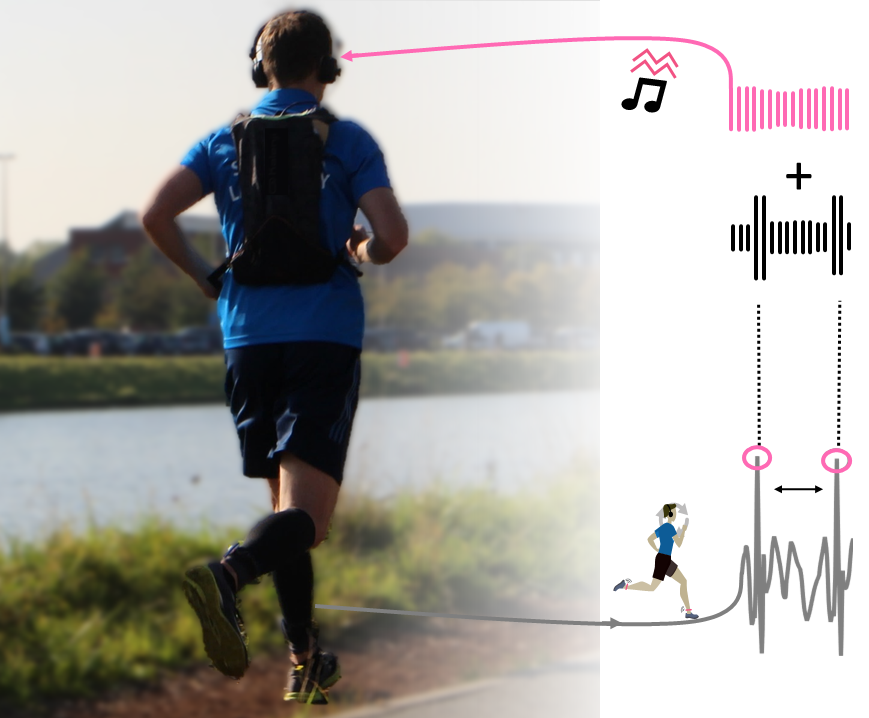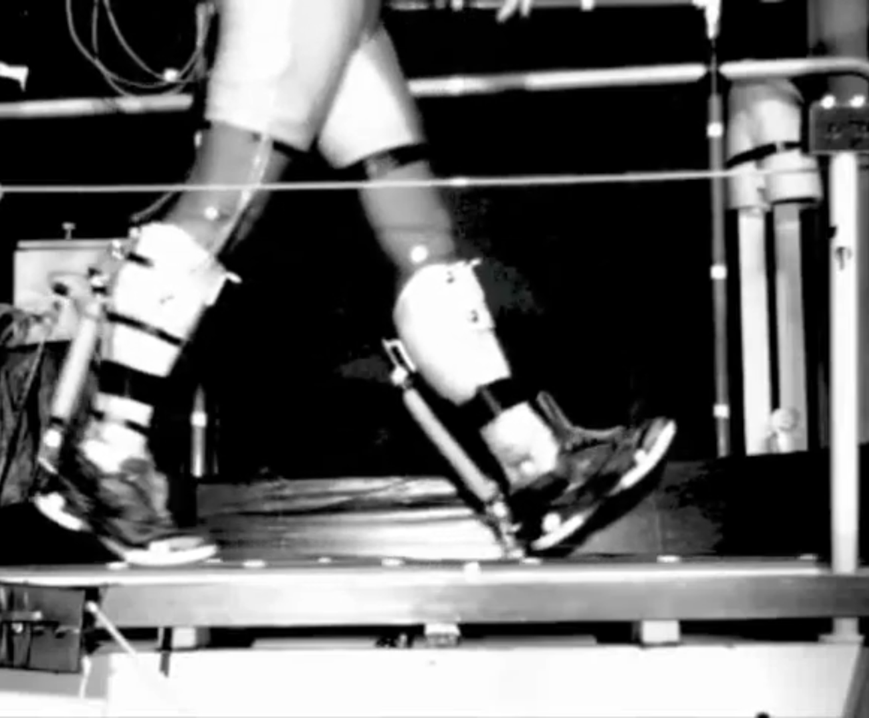You can find my full publication list at Google Scholar. Feel free to email me if you can’t find a copy.
Running biomechanics, impact loading, and wearable biofeedback

My PhD research was published as a BJSM PhD Academy Award, which aims “To gather the World’s leading PhD graduates to share their research related to sports and exercise medicine.
- Van den Berghe, P.
Free Full-Text - Motor retraining by real-time sonic feedback: understanding strategies of low impact running.
British Journal of Sports Medicine, 2022, bjsports-2022-105750.
Rather recently, I was invited by Drs. Peter Düking and Billy Sperlich to summarize several of the studies mentioned below in a book chapter with high quality graphics, published by Springer Nature.
- Van den Berghe, P.
A primer on wearable technology for injury risk management in distance running. In: Individualizing Exercise and Training Procedures with Wearable Technologies–Addressing Common Problems of Athletes.
Springer Nature, 2024.
Studies 1 to 5 concerned the development of a new strategy to measure impact continuously in real-time during distance running and to give instantaneous biofeedback to the runner, which enables high -impact runners to self-explore with running style adaptations that can lower impact intensity.
Study 1 lays the foundation of the measurement module for novel wearable technology. It involves a validity-reliability study of peak tibial acceleration as a real-time measure of impact loading in running.
Van den Berghe, P., Six, J., Gerlo, J., Leman, M., & De Clercq, D.
Validity and reliability of peak tibial accelerations as real-time measure of impact loading during over-ground rearfoot running at different speeds.
Journal of Biomechanics, 2019, 86, 238–242.
The feedback module is described in study. A musically inspired feedback strategy was developed that distorts music. The level of distortion was logically coupled to the level of impact.
- Lorenzoni, V., Van den Berghe, P., Maes, P.-J., De Bie, T., De Clercq, D., & Leman, M.
Design and validation of an auditory biofeedback system for modification of running parameters
Journal on Multimodal User Interfaces, 2019,13:167–80. Shared first authorship.
Study 3 delves into the effectiveness testing of the developed feedback prototype for impact reduction. We evaluated it first in a single session to provide proof of concept.
Van den Berghe P., Derie, R., Bauwens, P., Gerlo, J., Segers, V., Leman, M., & De Clercq, D.
Reducing the peak tibial acceleration of running by music‐based biofeedback: A quasi‐randomized controlled trial.
Scandinavian Journal of Medicine & Science in Sports, 2022, 32(4), 698–709.
In study 4, we propose a tuned analysis technique to detect time-related changes of impact loading in an individual. The analysis technique allowed to objectify changes otherwise only perceived by the individual.
- Van den Berghe, P., Gosseries, M., Gerlo, J., Lenoir, M., Leman, M., & De Clercq, D.
Free Full-Text - Change-Point Detection of Peak Tibial Acceleration in Overground Running Retraining
Sensors, 2021, 20(6), 1720.
In study 5, we evaluated the effectiveness of music-based feedback for impact reduction during running in a 3-week intervention in a rigorous RCT design with controls.
- Van den Berghe, P., Lorenzoni, V., Derie, R., Six, J., Gerlo, J., Leman, M., De Clercq, D.
Free Full-Text - Music-based biofeedback to reduce tibial shock in over-ground running: a proof-of-concept study.
Nature Scientific Reports, 2021, 11(1), 4091.
Study 6 is a follow-up of wherein my colleagues and I investigated biomechanical adaptations in high-impact runners who completed a gait retraining program for impact reduction
- Derie, R., Van den Berghe, P., Gerlo, J., Bonnaerens, S., Van Caekenberghe, I., Fiers, P., De Clercq, D., Segers, V.
Biomechanical adaptations following a music-based biofeedback gait retraining program to reduce tibial shock: a randomized controlled trial.
Scandinavian Journal of Medicine & Science in Sports, 2022, 32:1142–52.
Study 7 investigated the long-term effects of a 3-week music-based biofeedback intervention on running gait. While the intervention did not lead to lasting changes in impacts, runners were able to recall the trained running style six months later, leading to a substantial reduction in impacts
- *Van den Berghe, P.*, Derie R., Gerlo J., Bonnaerens S., Fiers P. Van Caekenberghe I., De Clercq D., Segers V.
Learning effects in over-ground gait retraining: A 6-month follow-up of a quasi-randomized controlled trial
Journal of Sports Sciences, 2024, 42, 6. Free postprint version - Zenodo
Studies 8-11 provide insight into possible strategies of low impact running.
In study 8, we classified rear foot strikes into typical and atypical groups using state-of-the art equipment of the Sport Science Laboratory, and compared multiple biomechanical variables between these groups. The typical rearfoot strikers had lower impact severity during level running at a submaximal speed.
- Van den Berghe P., Derie, R., Warlop, L., Breine, B., Gerlo, J., Leman, M., & De Clercq, D. (2019).
Consolidation of the atypical rearfoot strike pattern in distance runners and linkage to tibial shocks.
Footwear Science, 11(sup1), S146–S147.
The findings from study 9 suggest that 1D peak tibial accelerations depend on the manner of striking the ground with the rear part of the foot.
- Van den Berghe P., Warlop L., Derie R., Leman M., De Clercq D., Breine B.
Foot strike determines the center of pressure behavior and affects impact severity in heel-toe running.
Journal of Sports Sciences, 2022, Apr 3;40(7):808–20. Free postprint version - Zenodo
For study 10, the UGent research unit for Biomechanics of Human Movement had the opportunity to thoroughly describe, compare, and explain the running mechanics of a very successful long-distance runner who demonstrated low load and a high load capacity in comparison with a normative database of runners.
- Van den Berghe P., Breine, B., Haeck, E., & De Clercq, D.
Free Full-Text - One hundred marathons in 100 days: Unique biomechanical signature and the evolution of force characteristics and bone density.
Journal of Sport and Health Science, 2022, 11:347–57.
Study 11 investigated the impact of foot strike patterns on tibial accelerations in runners. It was a collaborative effort between international research groups active in academia and industry comprises a rather unique multi-center construct. The results showed that forefoot strikes had higher peak tibial accelerations compared to rearfoot strikes. This difference is important for applications like running monitoring and biofeedback.
- Van den Berghe P., De Bock S., Breine B., Horvais N., Gruber A., Six J., Samozino P., Leman M., Morin JB, De Clercq D., Giandolini M.
Peak tibial accelerations in different foot strike patterns during level running: an independent investigation in different cohorts.
Sports Biomechanics, Accepted on June 3th, 2024.
Where running biomechanics meets machine learning! Studies 11 and 12 involve collaborations with computer scientists to predict gait events (#11) and lab-based impact parameters (#12) from 3D tibial acceleration
Robberechts, P., Derie, R., Van den Berghe, P., Gerlo, J., De Clercq, D., Segers, V., & Davis, J.
Predicting gait events from tibial acceleration in rearfoot running: a structured machine learning approach.
Gait & Posture, 2021, 116544.Derie, R., Robberechts, P., Van den Berghe, P., Gerlo, J., De Clercq, D., Segers, V., & Davis, J.
Free Full-Text - Tibial Acceleration-Based Prediction of Maximal Vertical Loading Rate During Overground Running: A Machine Learning Approach
Frontiers in Bioengineering and Biotechnology, 2020, 8.
Exoskeleton-assisted walking and metabolic energy consumption

This study investigated the effects of unilateral and bilateral exoskeleton assistance during walking. Results showed that both unilateral and bilateral assistance reduced the metabolic cost, but bilateral assistance was more effective. The study highlights the importance of assistance symmetry for maximizing metabolic benefits in exoskeleton-assisted walking.
- Malcolm P., Galle S., Van den Berghe P., De Clercq D.
Free Full-Text - Exoskeleton assistance symmetry matters: Unilateral assistance reduces metabolic cost, but relatively less than bilateral assistance.
J Neuroeng Rehabil, 2018, 15:1, 74.
Human tissue imaging
I am currently involved in research that uses imaging techniques to study human muscle, bone, and brain tissue. This research is ongoing.